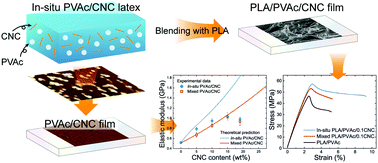Our official English website, www.x-mol.net, welcomes your
feedback! (Note: you will need to create a separate account there.)
Well-dispersed cellulose nanocrystals in hydrophobic polymers by in situ polymerization for synthesizing highly reinforced bio-nanocomposites†
Nanoscale ( IF 5.8 ) Pub Date : 2018-03-27 00:00:00 , DOI: 10.1039/c7nr09080c Shiyu Geng 1, 2, 3, 4, 5 , Jiayuan Wei 1, 2, 3, 4, 5 , Yvonne Aitomäki 1, 2, 3, 4, 5 , Maxime Noël 1, 2, 3, 4, 5 , Kristiina Oksman 1, 2, 3, 4, 5
Nanoscale ( IF 5.8 ) Pub Date : 2018-03-27 00:00:00 , DOI: 10.1039/c7nr09080c Shiyu Geng 1, 2, 3, 4, 5 , Jiayuan Wei 1, 2, 3, 4, 5 , Yvonne Aitomäki 1, 2, 3, 4, 5 , Maxime Noël 1, 2, 3, 4, 5 , Kristiina Oksman 1, 2, 3, 4, 5
Affiliation

|
In nanocomposites, dispersing hydrophilic nanomaterials in a hydrophobic matrix using simple and environmentally friendly methods remains challenging. Herein, we report a method based on in situ polymerization to synthesize nanocomposites of well-dispersed cellulose nanocrystals (CNCs) and poly(vinyl acetate) (PVAc). We have also shown that by blending this PVAc/CNC nanocomposite with poly(lactic acid) (PLA), a good dispersion of the CNCs can be reached in PLA. The outstanding dispersion of CNCs in both PVAc and PLA/PVAc matrices was shown by different microscopy techniques and was further supported by the mechanical and rheological properties of the composites. The in situ PVAc/CNC nanocomposites exhibit enhanced mechanical properties compared to the materials produced by mechanical mixing, and a theoretical model based on the interphase effect and dispersion that reflects this behavior was developed. Comparison of the rheological and thermal behaviors of the mixed and in situ PVAc/CNC also confirmed the great improvement in the dispersion of nanocellulose in the latter. Furthermore, a synergistic effect was observed with only 0.1 wt% CNCs when the in situ PVAc/CNC was blended with PLA, as demonstrated by significant increases in elastic modulus, yield strength, elongation to break and glass transition temperature compared to the PLA/PVAc only material.
中文翻译:

通过原位聚合在疏水性聚合物中分散良好的纤维素纳米晶体,用于合成高度增强的生物纳米复合材料†
在纳米复合材料中,使用简单且环保的方法将亲水性纳米材料分散在疏水性基质中仍然具有挑战性。在这里,我们报告了一种基于原位聚合的方法,以合成分散良好的纤维素纳米晶体(CNCs)和聚醋酸乙烯酯(PVAc)的纳米复合材料。我们还表明,通过将这种PVAc / CNC纳米复合材料与聚乳酸(PLA)混合,可以在PLA中达到CNC的良好分散性。通过不同的显微镜技术显示了CNC在PVAc和PLA / PVAc基质中的出色分散性,并进一步得到了复合材料的机械和流变性能的支持。在原位与通过机械混合生产的材料相比,PVAc / CNC纳米复合材料表现出增强的机械性能,并建立了基于相间效应和弥散的反映此行为的理论模型。混合和原位PVAc / CNC的流变和热行为的比较也证实了纳米纤维素在后者中的分散性有了很大的改善。此外,当原位PVAc / CNC与PLA混合时,仅用0.1 wt%的CNC即可观察到协同效应,与PLA / PVAc相比,弹性模量,屈服强度,断裂伸长率和玻璃化转变温度显着提高,证明了这一点。唯一的材料。
更新日期:2018-03-27
中文翻译:

通过原位聚合在疏水性聚合物中分散良好的纤维素纳米晶体,用于合成高度增强的生物纳米复合材料†
在纳米复合材料中,使用简单且环保的方法将亲水性纳米材料分散在疏水性基质中仍然具有挑战性。在这里,我们报告了一种基于原位聚合的方法,以合成分散良好的纤维素纳米晶体(CNCs)和聚醋酸乙烯酯(PVAc)的纳米复合材料。我们还表明,通过将这种PVAc / CNC纳米复合材料与聚乳酸(PLA)混合,可以在PLA中达到CNC的良好分散性。通过不同的显微镜技术显示了CNC在PVAc和PLA / PVAc基质中的出色分散性,并进一步得到了复合材料的机械和流变性能的支持。在原位与通过机械混合生产的材料相比,PVAc / CNC纳米复合材料表现出增强的机械性能,并建立了基于相间效应和弥散的反映此行为的理论模型。混合和原位PVAc / CNC的流变和热行为的比较也证实了纳米纤维素在后者中的分散性有了很大的改善。此外,当原位PVAc / CNC与PLA混合时,仅用0.1 wt%的CNC即可观察到协同效应,与PLA / PVAc相比,弹性模量,屈服强度,断裂伸长率和玻璃化转变温度显着提高,证明了这一点。唯一的材料。











































 京公网安备 11010802027423号
京公网安备 11010802027423号